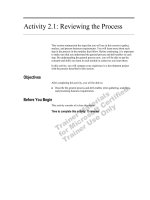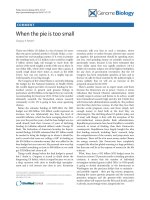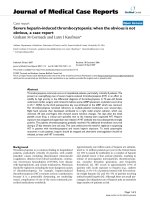- Trang chủ >>
- Mầm non - Tiểu học >>
- Lớp 5
5 2 1 when the disaster is over (social studies)
Bạn đang xem bản rút gọn của tài liệu. Xem và tải ngay bản đầy đủ của tài liệu tại đây (6.2 MB, 14 trang )
Suggested levels for Guided Reading, DRA,™
Lexile,® and Reading Recovery™ are provided
in the Pearson Scott Foresman Leveling Guide.
by Adam McClellan
Genre
Expository
nonfiction
Comprehension
Skills and Strategy
• Compare and Contrast
• Main Idea and Details
• Answer Questions
Text Features
•
•
•
•
Captions
Diagram
Headings
Glossary
Scott Foresman Reading Street 5.2.1
ISBN 0-328-13519-4
ì<(sk$m)=bdfbjg< +^-Ä-U-Ä-U
Reader
Response
When the
1. Compare and contrast the disaster that hit Armero in
1985 with the disaster that hit Goma in 2002. What
did they have in common? What was different? Use
a Venn diagram like the one below to write your
by answer.
Adam McClellan
Disaster’s Over
1985
Armero disaster
2002
Goma disaster
both
2. If you could interview someone who worked for
FEMA, what questions would you want to have
answered?
3. How are rubble and debris related? Use a thesaurus
or book of synonyms to find at least two more words
that have similar meanings.
4. This book contains headings to divide it into sections.
How do the headings help you to organize the
information in the book? How are the headings
arranged?
Editorial Offices: Glenview, Illinois • Parsippany, New Jersey • New York, New York
Sales Offices: Needham, Massachusetts • Duluth, Georgia • Glenview, Illinois
Coppell, Texas • Ontario, California • Mesa, Arizona
Natural Disasters and Their Aftermath
Every effort has been made to secure permission and provide appropriate credit for
photographic material. The publisher deeply regrets any omission and pledges to
correct errors called to its attention in subsequent editions.
Unless otherwise acknowledged, all photographs are the property of Scott Foresman,
a division of Pearson Education.
Photo locators denoted as follows: Top (T), Center (C), Bottom (B), Left (L), Right (R),
Background (Bkgd)
Natural disasters are shocking, and they can bring
tremendous destruction. They can destroy houses and
make streets impassable because of the floodwater or
debris that can accompany them. People can be hurt,
some of them badly; some even die.
All this comes from an event that might last only a
few seconds, such as a tornado, earthquake, or mudslide.
Recovering from a disaster, though, can take weeks,
months, even years. So as soon as a disaster is over, the
tough and dangerous work of disaster relief begins.
Disaster relief involves everything from finding and
caring for survivors, to communicating with the outside
world, to restoring civil order. It involves helping disaster
victims rebuild their homes, their local infrastructure, and
their lives. Disaster relief also involves figuring out how
the disaster happened, and finding ways to lessen the next
one’s impact.
Beach houses are
vulnerable to hurricanes.
Opener: Roger Ressmeyer/Corbis; 1 Digital Stock; 3 Getty Images; 4 Roger Ressmeyer/
Corbis; 6 Digital Vision; 8 Getty Images; 10 Getty Images; 11 ©DK Images; 12 Getty
Images; 13 ©DK Images; 14 Digital Stock; 16 Digital Stock; 17 ©DK Images; 18 Lauren
Hobart/FEMA News Photo/FEMA; 20 ©DK Images; 22 (C) Getty Images,(BR) ©DK
Images
ISBN: 0-328-13519-4
Copyright © Pearson Education, Inc.
All Rights Reserved. Printed in the United States of America. This publication is
protected by Copyright, and permission should be obtained from the publisher
prior to any prohibited reproduction, storage in a retrieval system, or transmission
in any form by any means, electronic, mechanical, photocopying, recording, or
likewise. For information regarding permission(s), write to: Permissions Department,
Scott Foresman, 1900 East Lake Avenue, Glenview, Illinois 60025.
2 3 4 5 6 7 8 9 10 V0G1 14 13 12 11 10 09 08 07 06 05
3
Looking for Survivors
One of the first and most important things that
happens after a disaster is the search for survivors. How
people search depends on the damage that has been done.
Following an earthquake, hundreds or even thousands of
people may be trapped underneath the rubble of collapsed
buildings and other structures.
An earthquake near San Francisco in 1989 caused
several bridges and overpasses to collapse, killing some
people and trapping others in their cars. Rescue teams of
doctors and firefighters arrived quickly to free survivors and
give them the medical help they needed.
People use whatever means are available to rescue
trapped survivors. In November 1985, the Nevado del Ruiz
volcano in Colombia erupted, sending tons of hot mud
and water sliding down the mountainside and destroying
the small town of Armero that lay below. Some people
survived the eruption by climbing onto rooftops and into
trees to avoid the deadly flow; others found themselves
stuck in a soft, gooey mud that was deep and widespread.
In many cases the best way to rescue survivors was to
fly a helicopter close to the ground and then have rescuers
lower themselves down to the trapped survivors. The
rescuers could then get hold of the survivors and fly them
away to get medical help.
The mess created by a
natural disaster can take
weeks to clean up.
4
5
Natural disasters can
completely destroy even
the most modern houses.
Caring for Survivors
It’s not only people who try to help disaster survivors.
Rescue dogs can do work around disaster sites that people
couldn’t possibly perform. They’re trained to sniff out the
scent of human beings, which enables them to point out
survivors hidden under rubble. The dogs learn to treat the
search as a game, and they get food and other rewards
when they find a trapped survivor. Dogs are good at this
work because their sense of smell is much more sensitive
than that of humans, and their rescue efforts following in
the wake of disasters have helped save many lives.
6
Survivors of a disaster have many needs. They may
be injured and require medical care. Often, they have
either lost their home or been forced to evacuate. These
survivors will need food, shelter, and other vital necessities
until they can find a new place to live. Many must also deal
with the shock of having gone through the disaster.
Several disaster relief organizations specialize in caring
for survivors. When disaster strikes, these organizations
spring into action in order to bring workers and supplies
to the damaged areas. One of the best-known relief
organizations is the Red Cross. The Red Cross helps people
in most countries of the world. It keeps lists of hundreds
of volunteer experts who can be called on during an
emergency. The Red Cross also trains local residents to
respond to disasters. That way, when disaster strikes, teams
of people are already in place and ready to take action.
7
The Red Cross often sets up “tent
cities” to help disaster survivors.
After a disaster, the Red Cross is often on the scene
right away to meet the needs of survivors. Volunteers set
up shelters at safe locations, providing places to stay for
those who cannot return to their homes. The Red Cross
also takes on the big job of feeding disaster victims and
emergency workers.
The victims of natural disasters, who suffer injuries
ranging from minor cuts to far more serious wounds, have
major medical needs. The Red Cross helps meet those
needs by sending nurses to the scene of the disaster.
Helping the nurses are many other medical workers
such as paramedics. Paramedics work to treat the wounded,
and also transport them to sites where their injuries can
be given proper care. Hospitals often overflow with those
requiring medical care, and doctors and nurses work to give
survivors the treatment and care that they need.
8
In some cases the medical facilities and personnel at
a disaster site are not enough to meet the needs of the
survivors. When this happens, doctors and nurses from
outside the area may come in to care for the wounded.
One major medical relief group is Doctors Without
Borders, an international organization that works to
ensure that people everywhere receive medical care. To
aid in disaster relief, Doctors Without Borders may send
volunteer doctors and nurses to disaster sites.
Heavy rains and flooding struck many areas in the
countries of Haiti and the Dominican Republic in May
2004. Doctors Without Borders sent emergency teams to
the region. They set up local health centers and took care
of the most serious injuries and illnesses there. They also
brought with them thousands of emergency kits that were
used to treat people who were not hurt as badly.
9
In some cases, the worst health problems happen in the
days following a disaster. Damage to sewer systems can
make water unsafe to drink, and people who drink water
that has been made unsafe by damaged sewer systems can
develop serious illnesses such as cholera and typhoid fever.
Cholera victims suffer intense dehydration. Their
bodies lose so much water that the illness rapidly becomes
life-threatening. Quick medical help often saves many
cholera victims, but delays can be fatal.
In contrast to cholera victims, typhoid fever victims
suffer from a steady fever that can run as high as 104°F,
along with weakness and head and stomach pains. Modern
medicines work effectively against typhoid fever, but it is
important that they are administered quickly, for without
treatment, this illness can be deadly. The efforts of medical
workers, combined with the clean drinking water brought
by relief workers, can keep people healthy after a disaster.
A disaster can be hard on people even if they aren’t
physically hurt by it. They may lose their homes, their jobs,
or even their family members. It can take years for people
to recover from the effects of such losses, and as a result
disaster relief workers have now started providing more
psychological support to those affected by disasters.
A deadly earthquake struck India in January 2001. The
Indian and American Red Cross organizations worked
together to develop a program to give counseling to the
victims. They trained local psychologists to help survivors
talk about the disaster and what they would face in the
future. This helped the
survivors take the
first steps toward
putting their
lives back
together.
Flooding can damage
sewer systems and make
water unsafe to drink.
People who live or travel in
earthquake-prone areas may
carry emergency “Quake-Paks”
such as the one shown above.
10
11
Emergency medical kits such as
this are carried by disaster relief
workers to give quick attention
to first-aid needs.
Communications
Another important part of disaster relief is getting
information about the disaster to the outside world. Some
of this work is done by news reporters, as newspapers, TV
networks, and news Web sites send journalists to the scene
of the disaster to tell what happened and what is being
done to help survivors.
By bringing the disaster to people’s attention, the media
can help get resources to relief workers. When people
learn about the damage caused by a disaster, they are more
likely to donate money, time, and blood to help its victims.
Millions of people donated such resources to the victims of
the tsunami that hit southeast Asia in December 2004.
12
Disaster victims have many different needs, depending
on what kind of disaster has happened. Earthquakes often
injure thousands of people, creating a demand for many
donations of blood. Blood spoils quickly, even when it’s
refrigerated, and as a result fresh donations are often
needed to help earthquake victims who need more blood.
In other situations, the greatest need may be creating
shelter for survivors. For example, in January 2002, a
volcano erupted near the city of Goma in the Democratic
Republic of the Congo, a country in central Africa. The
eruption destroyed thousands of homes. What disaster
relief organizations needed the most was plastic sheeting
to create simple temporary shelters, along with basic
household items such as blankets and cooking equipment.
13
Getting the right kind of aid can be hard. We often
think that “every little bit helps,” and that’s mostly true.
However, when organizing a disaster relief effort, getting
the wrong things can actually hurt. Sorting through
donations to take out unnecessary items takes time, and in
an emergency, time is precious. Therefore it’s important for
relief groups to tell people the right things to donate.
It’s critical to make accurate and detailed reports about
a disaster’s relief needs. Other kinds of communication
are also important. Survivors want to let people know that
they’re all right following a disaster. Friends and family
who live outside the disaster zone want to find out about
their loved ones. Phone and power services may have
been knocked out by the disaster, making communication
difficult. The Red Cross helps here too. Survivors can ask
that the Red Cross let their family members know how
they are, and friends and family can ask the organization to
find out about people living in the disaster area.
14
Restoring Order
It’s not just buildings and people that get hurt in
disasters; the normal order of things breaks down too. After
a flood, streets may be turned into wide streams or become
blocked by mud or rubble. Even if a disaster has left the
streets dry, the traffic light system may not work due to
damage to the electrical grid. The aftermath may include
other dangers, such as fires, gas leaks, and downed power
lines. On top of all this, people are often confused about
what to do following a disaster. With so many things to do
all at once, people might have difficulty creating priorities.
Bringing order out of all this chaos is not easy.
Overturned cars are just one example
of the chaos created by disasters.
15
The National Guard
can be called out to
help clean up floods.
Often the survivors themselves will help after a disaster.
The 1989 earthquake disrupted San Francisco’s traffic light
system, so residents of some neighborhoods took to the
streets to direct traffic with flashlights. Usually the impact
of the disaster is so great that civilians cannot bring calm
and order themselves. In fact, the disorder may be too great
for local police departments to handle. In that case, outside
forces may be brought in to help.
In the United States, the National Guard plays a key
role in bringing order to disaster areas. The National Guard
is officially a part of the United States Army, but one of its
primary missions is to help out after disasters. Following
a disaster National Guard forces protect property, move
people away from danger, and work with relief groups.
Some of the worst health problems occur well after a
natural disaster has hit. In a similar way, some of the worst
destruction happens hours, or even days, after the initial
disaster has ended. The events surrounding the 1906 San
Francisco earthquake illustrate this perfectly.
16
Badges like the one shown here
help people identify rescue
workers following a disaster.
The 1906 San Francisco
earthquake caused a huge
amount of destruction. But
the worst damage came not
from the earthquake, but rather
from the fires that were started by broken gas lines.
The fires raged through San Francisco for four days,
causing damages estimated at $500 million, an amount
equal to billions and billions of dollars in today’s money.
In combination with the earthquake, the fires left 200,000
people homeless, out of a total population of 450,000.
Nowadays, to prevent this kind of damage from
happening again, firefighters work quickly to put out any
fires started by earthquakes and other natural disasters.
Crews of workers from gas and electric companies also
work hard to find and repair any gas leaks or downed
power lines that can cause fires.
17
The inside of a
FEMA office
Rebuilding
After a disaster has passed, people must start to rebuild.
Homes and businesses may have been damaged. Roads
and highways have often been blocked. In the worst cases,
whole towns may have been wiped right off the map.
People have to decide what can be rebuilt and what must
be torn down.
Doing either can be very expensive. Often, insurance
helps cover the cost of fixing homes and businesses. The
owners of homes and businesses pay money to insurance
companies to cover their costs if disaster hits them.
However, the money that insurance provides is often not
enough to cover all the costs.
In some cases insurance may not cover any costs at
all. For example, flood damage is not covered by regular
insurance; people need to have special flood insurance.
The great floods along the Mississippi River in 1993 caused
more than $10 billion in damage, but many of the people
living along the river did not have flood insurance.
18
In the United States, the Federal Emergency
Management Agency, or FEMA, helps people, businesses,
and local governments with the cost of rebuilding. People
who have lost their homes can turn to FEMA for help in
finding shelter. FEMA loans money to disaster survivors to
help them rebuild their homes.
FEMA also helps local and state governments by
giving out aid money for the rebuilding and repairing of
infrastructure. Things like roads and bridges get destroyed
by natural disasters, and it takes money to fix them.
In some cases, though, it may not make sense to
rebuild. After the 1993 Mississippi River floods, the federal
government bought land back from many farmers who
had settled close to the river. In one case, the whole town
of Valmeyer, Illinois, was moved to a new spot! Valmeyer’s
original location along the banks of the Mississippi made
it prone to flooding. So it was moved to an area several
hundred feet above the river, thereby helping people avoid
millions of dollars in potential damages from future floods.
19
Analyzing What Happened
Of course, there’s no way to stop natural disasters from
happening. We don’t know how to make an earthquake
more gentle or how to slow down the winds of a hurricane.
But there are things that can be done to keep people safer
when natural disasters do strike.
In February 1976, an earthquake hit the Central
American country of Guatemala. The quake killed or
injured about 100,000 people. Many of the deaths occurred
when peoples’ houses collapsed on top of them. Since the
houses were constructed of a mud-brick mixture, they fell
apart quickly under the strong shaking of the earthquake.
To keep this from happening again, the Guatemalan and
United States governments sold survivors wood and metal
building materials for less than they actually cost. Wood
and metal can absorb the shaking of an earthquake much
better than brick can. As a result, future earthquakes in
Guatemala should cause much less damage.
Disasters will never stop happening. They’re part of
life on Earth. Terrible things can happen sometimes, and
there’s not much we can do to stop it. But when disaster
does strike, the hard and dangerous work of disaster relief
makes a huge difference. By caring for survivors, helping
them rebuild their lives, and looking for ways to make
future disasters less devastating, we find ways of
bringing life back to normal.
A diagram illustrating
the damage earthquakes
can cause.
Before earthquake
20
After earthquake
21
Now Try This
We Interrupt This Program . . .
Breaking news—a disaster has struck! But the details
are still sketchy. What this calls for is some top-notch
reporting. Work together with a group of your
classmates to create a news bulletin about a
fictional disaster. In telling the story, focus on
the disaster relief work that’s being
done to help survivors.
to Do It!
w
o
H
s
’
e
r
He
1 First, decide on the main story you need to tell. What
kind of disaster has hit? Where has it happened? How
have people been affected? How are disaster relief
efforts helping to make the situation better?
2 Next, choose roles for everyone in your group. One or
two people can work as news anchors who introduce
and explain the reports. The other members of the
group can be on-the-scene reporters, each telling about
a different part of the disaster.
3 Work together to create at least two visual aids to go
with your report. They can show information about the
disaster and its aftermath as well as the disaster relief
work being done to help survivors. What can you create
to help your classmates understand the disaster and the
events that followed it?
4 Practice your newscast together. Then break the news
to your classmates as part of a classroom news bulletin.
22
23
Reader Response
Glossary
aftermath n. a result or
consequence, especially of
something destructive.
chaos n. severe disorder
and confusion.
debris n. scattered pieces
of destroyed materials.
dehydration n. major loss
of water from the body.
infrastructure n. the
basic things that help a
community function, such
as roads, electricity, and
water systems.
insurance n. a promise
to pay out money in case
of a loss, in exchange for
regular payments.
evacuate v. to leave a
dangerous place.
psychological adj. related
to the mind or to human
emotions and behaviors.
impassable adj.
impossible to travel on or
through.
rubble n. broken bricks or
stones that have fallen off
damaged buildings.
1. Compare and contrast the disaster that hit Armero in
1985 with the disaster that hit Goma in 2002. What
did they have in common? What was different? Use
a Venn diagram like the one below to write your
answer.
1985
Armero disaster
2002
Goma disaster
both
2. If you could interview someone who worked for
FEMA, what questions would you want to have
answered?
3. How are rubble and debris related? Use a thesaurus
or book of synonyms to find at least two more words
that have similar meanings.
4. This book contains headings to divide it into sections.
How do the headings help you to organize the
information in the book? How are the headings
arranged?
24









